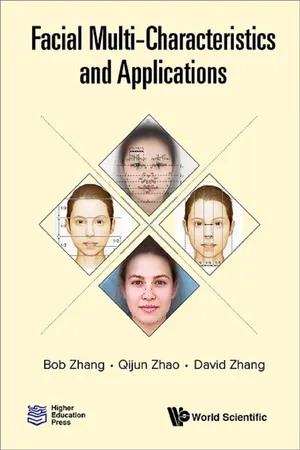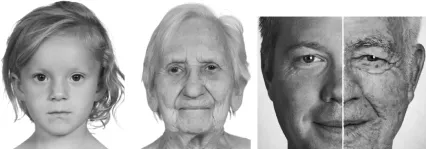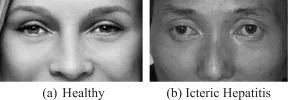![]()
Chapter 1 Introduction
Faces with multi-characteristics have long been a source of interest to psychologists and other scientists in a wide range of disciplines. Many different types of important information are visible in faces. In this Chapter, two main features (e.g., permanent features and changed features) are defined, where permanent features can be separated into special (or unique) features for individuals and common features for some particular crowds. On the other hand, changed features are obtained by some disease or by some stimulus. In addition, each type of feature can be found from its corresponding application, including facial identification in permanent special features, beauty analysis in permanent common features, facial diagnosis by disease changed features, and expression recognition by stimulus changed features.
1.1 Why Faces with Multi-Characteristics
Human faces play an important role in our social life, from which we can extract many kinds of information, such as identity, gender, race, age, emotion, health, personality, and attractiveness. In recent years, thanks to the significantly improved performance of computers and digital cameras, computerbased facial image analysis has attracted extensive attention. The most investigated research topic is face recognition, which has been successfully applied in entrance control, homeland security, and computer security (Li and Jain, 2011; Kawulok et al., 2016). In addition, some other applications, like facial expression recognition (Simon, 2008; Faigin, 2008; Bhatia, 2012), facial beauty analysis and facial diagnosis (Kiviluoma, 2013; Zhang et al., 2016; Meneghini, 2005), have also attracted the attention of researchers from many different fields.
A human face is a complex object with varying features. What features can we extract from the face and what applications can these features provide? This chapter will answer these questions. In fact, we can find multicharacteristics from a face, which may be classified into two main types of features, e.g., permanent (or physiological) features and changed features obtained by some outside influences during one’s lifetime. For example, a birthmark on the face can be taken as a permanent feature, while erythema morbilliforme on the face can be categorized as a changed feature (see Fig. 1.1).
Fig. 1.1 (See Color) A typical example where a birthmark is a permanent feature and erythema morbilliforme is a changed feature.
Furthermore, the permanent features can also be separated as two types: special (or unique, such as a birthmark) for individuals and common for some particular crowds (like men/women group); and the changed features can be obtained by disease (such as erythema morbilliforme) or by some stimuli (e.g., a belly laugh if someone heard a funny joke). As a result, these different kinds of features can be applied for different applications, including facial identification for permanent special features, facial beauty analysis for permanent common features, facial diagnosis by disease changed features, and facial expression recognition by stimulus changed features. Based on these definitions, the guideline of this book is summarized in Fig. 1.2.
Fig. 1.2 Book guideline of facial multi-characteristics and applications.
1.2 Facial Authentication Using Permanent Special Features
As one of the most successful applications of facial multi-characteristics, facial authentication has received significant attention. There are at least two reasons for this trend: the first is the wide range of commercial and law enforcement applications, and the second is the availability of feasible technologies (Li and Jain, 2011; Kawulok et al., 2016). The strong need for user-friendly systems that can secure our assets and protect our privacy without losing our identity in a sea of numbers is obvious. Although very reliable methods of biometric personal identification exist, for example, fingerprint analysis and iris scans, these methods rely on the cooperation of the participants, whereas a personal identification system based on analysis of frontal or profile images of the face is often effective without the participant’s cooperation or knowledge (Ahonen et al., 2006; Huh et al., 2014; Kowner, 1996; Penton-Voak, 2011; Peron et al., 2012; Wechsler, 1998; Zhang, 2002).
Since everyone knows that a face may not exactly be the same with others, there should be some unique features for each individual. This means that each face should have some permanent special features, like geometric features (Liu et al., 2002; Melacci et al., 2010; Mexican, 2003; Philips et al., 2000; Whitehill et al., 2008). We can then use the different methods to extract these features (e.g., the distances between fiducial points) in faces or face profiles. Some typical facial authentication methods by extracting different special geometric features are shown in Fig. 1.3.
Fig. 1.3 Different facial identification methods by using geometric features.
1.3 Facial Beauty Analysis Using Permanent Common Features
As the saying goes, things of a kind come together. This means that people of one kind fall into the same group (Farkas et al., 1985; O’Toole et al., 1999; Perrett et al., 1994; Perrett et al., 1999; Sala et al., 2013; Scheib et al., 1999; Schmid et al., 2008; Slater et al., 1998; Laurentini et al., 2014). In fact, there would be many different kinds of groups in human society. Each group should have some permanent common features extracted from their faces. For example, based on the given facial images, we can easily find out each men/women group (see Fig. 1.4), white/black/yellow group (see Fig. 1.5), and young/old age group (see Fig. 1.6), respectively. If taking facial beauty as a group, we can also analyze its characteristics by the existing common features.
Fig. 1.4 Typical example of each men and women group.
Fig. 1.5 (See Color) Typical example of each white, black and yellow group using color features.
Fig. 1.6 Typical examples of each young/old age group separated by texture features.
Facial beauty analysis is an emerging research area. What defines the human perception of beauty is a long standing problem in human sciences. More recently, this problem has spread into medical including areas such as plastic surgery and orthodontics. If we take facial beauty as a class, it is significant to know how to obtain an effective beauty analysis method by extracting its permanent common (physical) features. Actually, some sculptors and painters believed that the golden ratio is the underlying measurement of beautiful faces in ancient time. The vertical thirds and horizontal fifths rule was also proposed in ancient China. Since the 1990s, the study of facial beauty perception has been popular in psychology and some influential hypotheses (such as the averageness) have been presented. Facial beauty study has attracted the attention of computer scientists since 2000. Biometric techniques based on statistical pattern recognition and feature extraction have also been used for facial beauty modeling and developing real-life application systems (Alley et al., 1991; Apicella et al., 2007; Atiyeh et al., 2008; Berlin et al., 2014; Berssenbrugge et al., 2014; Chen et al., 2014; Choe et al., 2004; Eisenthal et al., 2006; Fan et al., 2012; Gan et al., 2014; Gray et al., 2010; Gunes et al., 2006; Langlois et al., 1990; Langlois et al., 2000; Leyvand et al., 2008; Little et al., 2011; Marrin J G, 1964; Martin-Loeches et al., 2014; Rhodes, 2006; Thornhill et al., 1993; Yan, 2014). As a typical example, some permanent common features extracted from a beauty class can be given in Fig. 1.7.
Fig. 1.7 (See Color) Typical examples of facial beauty/other groups analyzed by some common features.
Except for permanent (physiological) features extracted from our face, we can also find some changed facial features generated by a means of stimulus or disease influence. We will discuss their applications in the following two sections.
1.4 Facial Diagnosis by Disease Changed Features
Facial diagnosis, i.e., facial inspection, is one of the important diagnostic methods in Traditional Chinese Medicine (TCM). It is used to observe the abnormal changes in the face to make the diagnosis of disease (Zhang, 1990, Zhu et al., 2006; Lukman et al., 2007; Zhang et al., 2015; Kiviluoma, 2013). Facial diagnosis has been widely applied to clinical analysis and applications in TCM for thousands of years. The simplicity, inexpensiveness, and noninvasiveness of facial diagnosis makes it very competitive in the development of remote diagnosis. Whenever there is a complex disorder full of contradictions, examination of the face can instantly clarify the main pathological processes. Many TCM medical practitioners utilize facial features such as color and texture to differentiate syndromes and diagnose disease.
Various kinds of facial traits, including facial color and texture, have been inspected and analyzed by TCM practitioners for retrieving significant pathological information from the human body. Among the types of extracted medical information, facial chromatic features play a vital part in evaluating a patient’s condition. This means that color patterns inspected from individual may lead to a distinct diagnostic result. In addition, various types of facial texture styles have also provided plenty of valuable information for diagnosis. As a result, certain facial traits may reveal vital clues to one’s underlying health condition. We would worry more about a change in facial appearance if there are any new symptoms (Rai et al. 2015). For a typical case, a healthy sample and Icteric Hepatitis sample can easily be separated by facial color features (see Fig. 1.8).
Fig. 1.8 (See Color) Comparison of two different facial images (Healthy and disease-Icteric Hepatitis) by color feature.
1.5 Expression Recognition by Stimulus Changed Features
Automatic facial expression recognition and analysis has been an active topic in the scientific community for over two decades (Fasel et al., 2003; Butalia, 2012; Dure...








